Beekeeping, also known as apiculture, is an exciting hobby and a viable business option for many. What is backyard beekeeping? It’s maintaining bee colonies in a controlled environment, typically in your backyard, to collect honey, beeswax, and other products. People often wonder, “How much does a beekeeping farm cost?” or “How to raise bees cheap?”
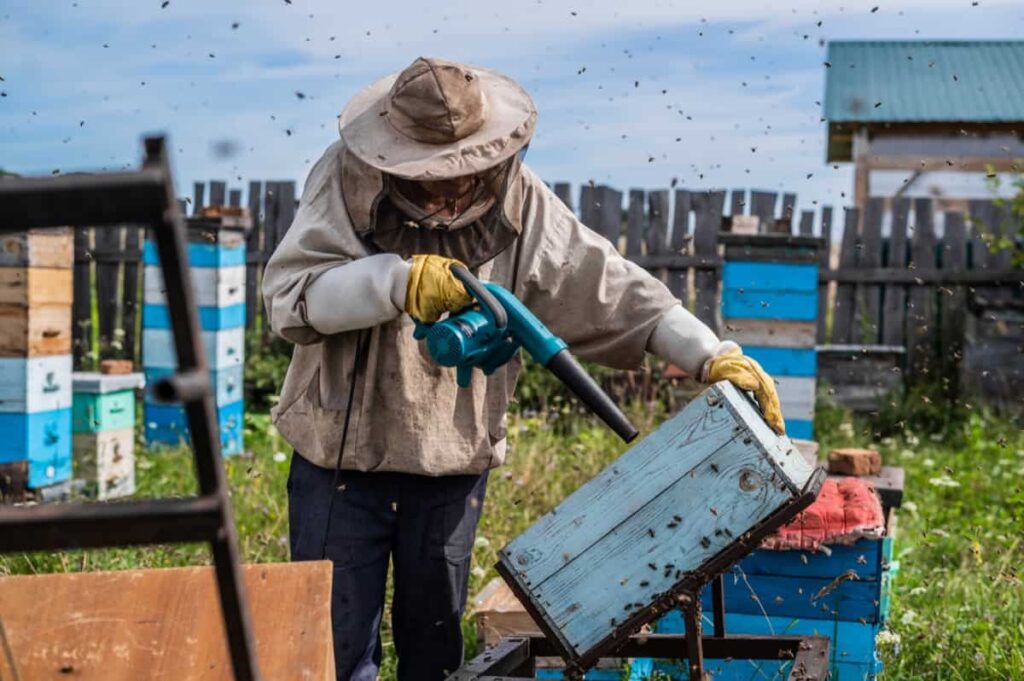
The cost varies, but starting beekeeping in your backyard is generally more affordable than setting up a large commercial operation. Is beekeeping profitable? It can be, especially when considering the most profitable part of beekeeping: selling honey and other bee-related products.
But the profitability depends on various factors like the cost of beehives, how much a queen bee costs, how much a beehive with bees, and how much a bee colony costs. The key is understanding the costs involved, knowing how much beekeepers make, and employing smart tips to keep expenses low. In this article, we’ll go through the factors affecting the cost of backyard beekeeping, initial investment, and tips to reduce these costs.
Factors Affecting the Cost of Backyard Beekeeping
Several things influence the cost of beekeeping in your backyard. Firstly, location matters. You may need to get permits in some places, which will add to the cost. The type of bees you choose also impacts how much honey bees cost. Then comes the equipment. Depending on your needs, a beekeeping equipment list can be long or short.
Seasonal factors also play a role; for example, you might need to provide supplemental food for the bees during winter, affecting how much bees cost overall. Market prices for bee products can also fluctuate, impacting how much beekeepers make and determining if your venture is profitable. Lastly, the health of your queen bee is crucial because replacing her affects how much a queen bee costs. A well-thought-out approach can help manage these costs effectively.
Initial Investment for Backyard Beekeeping
The startup costs for backyard beekeeping can be a barrier for many. When considering how much a beehive with bees, a standard beehive can range from $200 to $350. Then, you need a queen bee. So, how much does a queen bee cost? Generally, a queen bee costs around $25 to $40. Now, let’s talk about the bee colony. How much does a bee colony cost? A package of bees, which includes a queen and enough worker bees to start your hive, can range from $100 to $150.
This brings the cost of the hive and the bees to around $350 to $540. You’ll also need protective gear, tools, and possibly medications for the bees. Summing up these items, the initial investment can easily exceed $700. Additional costs like sugar for feeding the bees and jars for honey storage can add another $50 to $100. Therefore, the initial cost can hover around $750 to $900.
Cost of Beehives and Equipment
Beehives and equipment form a significant part of your initial investment and recurring costs. Let’s start with the beekeeping equipment list. Essential items include a smoker ($20-$40), hive tool ($10-$20), bee brush ($5-$15), and protective clothing ($50-$150). Altogether, this equipment can cost up to $225. Now consider the hive itself.
In case you missed it: 11 Best Beekeeping Suits for Men and Women: Prices Included for Beekeepers in the USA
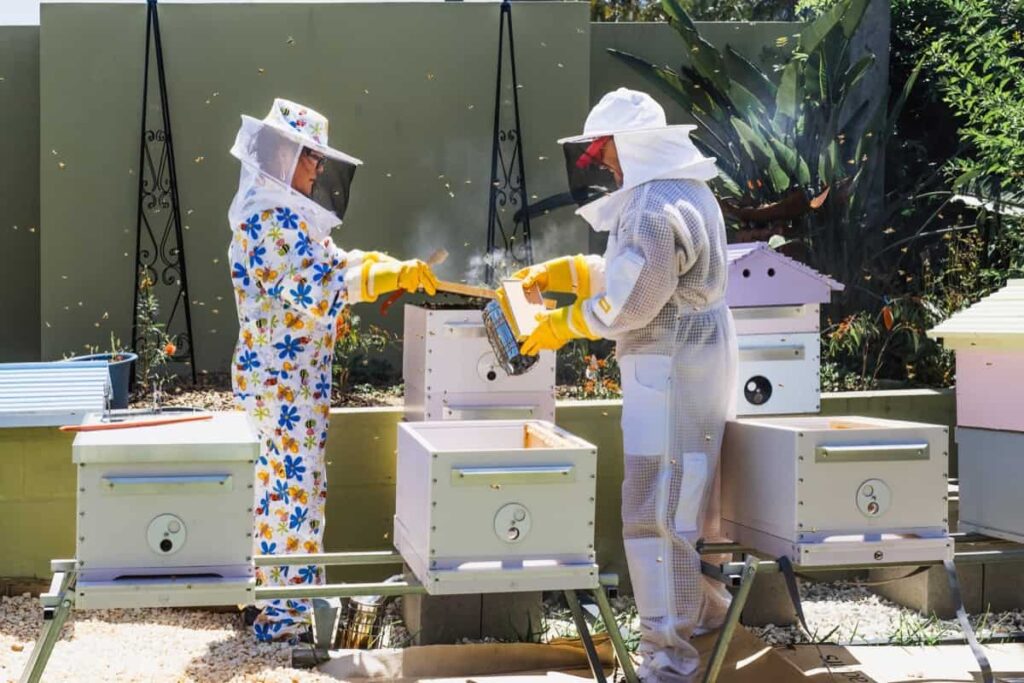
Wooden Langstroth hives are commonly used and cost around $200 to $300. But other hive types like top bar and Warre hives can be less expensive, offering a way to raise bees cheaply. Then, there are frames and foundations for the bees to build their comb, costing around $50 for a set. To harvest the honey, you’ll need an extractor, which can cost between $100 and $400, though this is a one-time investment. All these costs add up but are essential for a successful beekeeping venture.
Expenses for Bees and Queens
Regarding bees and queens, the costs can vary depending on the type of bee and where you purchase them. Typically, a package of bees, which includes a queen and enough workers to start a hive, can range from $100 to $150. How much does a queen bee cost separately? A queen bee can range from $25 to $40.
These costs can add up quickly if you plan on having multiple hives. For example, if you’re setting up three hives, just the bees and queens alone can cost you between $375 and $570. Buying locally can sometimes reduce these costs, but availability can be limited, particularly in colder climates where bees may not be locally sourced.
Costs Associated with Honey Production
Honey production can be the most profitable part of beekeeping, but it also comes with its own set of costs. First, you’ll need an extractor to remove honey from the frames, costing between $100 and $400, depending on the type and size. You’ll also need containers to store the honey, ranging from simple jars that may cost a few cents each to specialized honey storage containers that cost a couple of dollars each.
Filters to remove impurities from the honey can cost around $20 to $50. Additional costs such as labeling, packaging, and marketing should also be considered if you plan on selling your honey. These can vary widely, but expect to spend at least $50 to $200 initially for these business-related expenses.
Maintenance and Upkeep Expenses for Backyard Beekeeping
Maintenance and upkeep are ongoing costs that can impact the profitability of your beekeeping venture. You’ll need to regularly inspect and possibly replace parts of your hive, costing around $20 to $50 per hive per year. Although a one-time investment, protective gear can wear out and need replacing, costing another $50 to $150 when it does.
In case you missed it: Honeybee Farming Operations Management: Month-Wise Beekeeping Maintenance for Better Profits
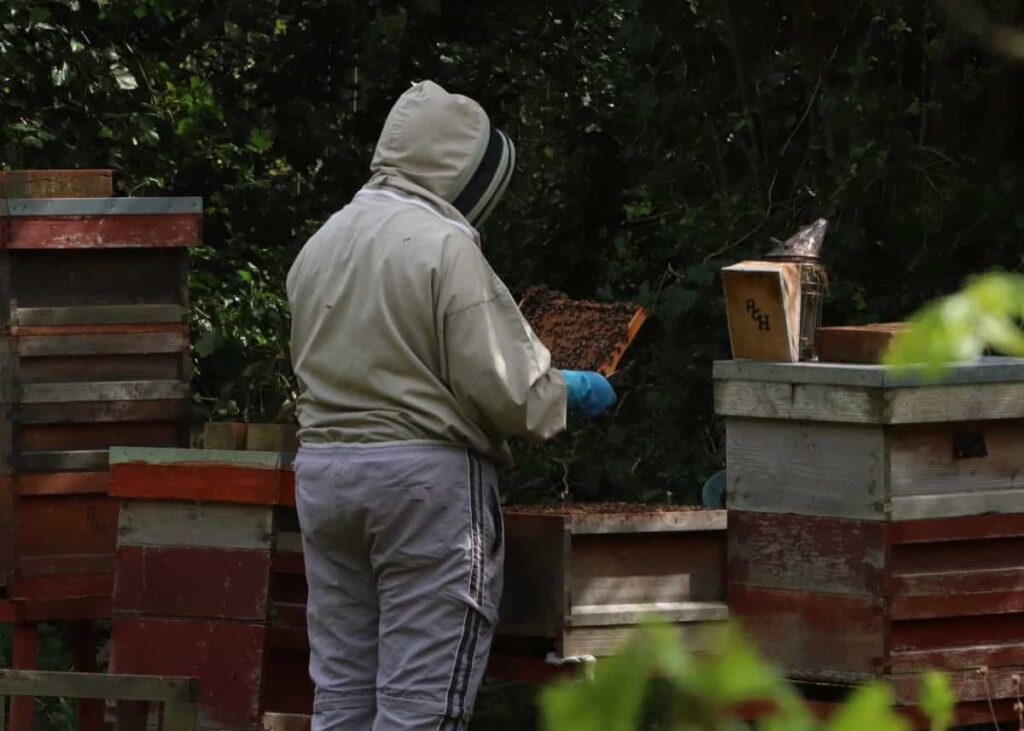
Feeding your bees during the off-season with sugar or specialized bee food can add $20 to $50 per hive per year. Then there are costs for tools like smokers and hive tools, which may need occasional replacement, adding another $10 to $40 to the annual cost. All told, you can expect to spend a minimum of $100 to $300 per year on maintenance and upkeep for each hive, not counting any unexpected issues that may arise.
Costs of Pest and Disease Management
You’ll likely need to invest in chemical treatments or organic alternatives for mite control and other common bee ailments. These treatments range from $20 to $50 per hive per season. In extreme cases, if a hive becomes too infected, you might have to replace the entire colony, which, as we’ve discussed, can cost between $100 to $150.
In addition to the treatments, you may need to replace infected frames or other hive parts, adding another $20 to $50. While these expenses might seem small individually, they can quickly accumulate, especially if you have multiple hives to manage. Therefore, budgeting for pest and disease management is vital as part of your overall beekeeping expenses.
Insurance and Legal Considerations for Backyard Beekeeping
Insurance and legal considerations are often overlooked but essential aspects of backyard beekeeping. To begin with, liability insurance can cost anywhere from $300 to $500 per year to protect against any damages or accidents involving your bees. This is crucial, especially if you live close to neighbors or public areas where people may be stung. Depending on your local jurisdiction, you may also need permits or licenses for keeping bees, ranging from $20 to $100.
Zoning regulations might also require a one-time expense to ensure your property is suitable for beekeeping, which can cost an additional $50 to $200 for property assessments or modifications. Some municipalities might require periodic inspections, costing about $25 to $50 per visit. Failing to account for these legal and insurance costs can lead to unexpected expenses and legal issues, making it vital to include them in your beekeeping budget.
Training and Education Costs for Beekeepers
As with any specialized activity, beekeeping benefits from proper training and education. You can start learning through online courses ranging from free to $200. However, hands-on training is often recommended for a more in-depth understanding of bee behavior and hive management. The price of workshops and seminars varies, typically ranging from $50 to $300. This depends on how experienced the trainers are and their reputation.
In case you missed it: Beekeeping Business Plan: Bee Farming Cost, Profit, and Project Report in India
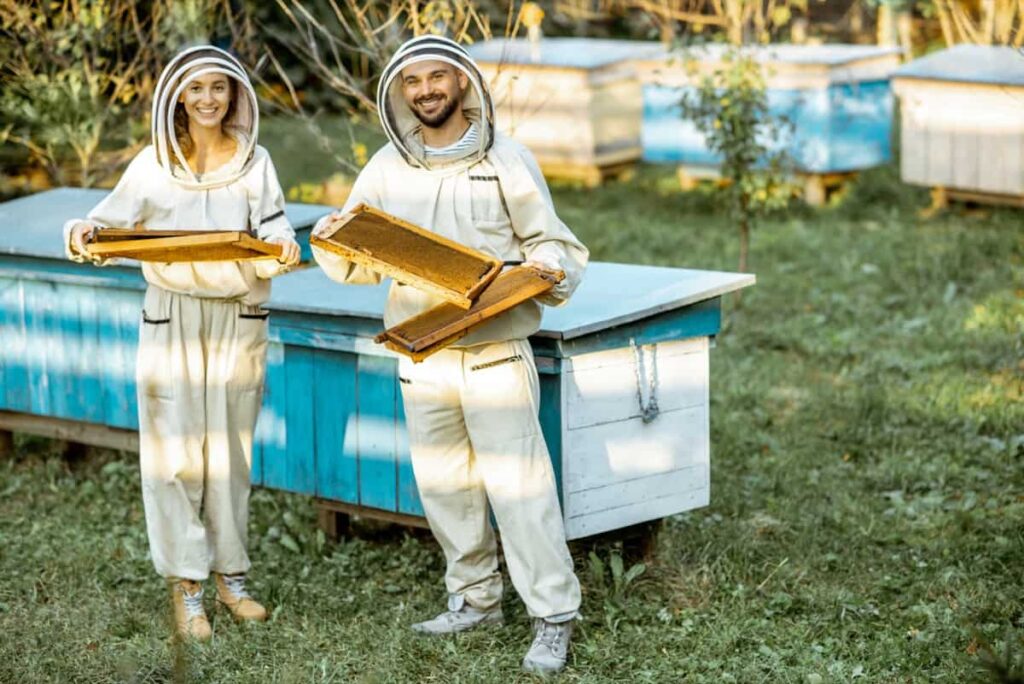
Books and other educational materials can add another $20 to $50 to your initial investment. Membership in beekeepers’ associations for networking and continued learning is also advisable; these can cost around $25 to $100 per year. In the beginning years of beekeeping, plan to invest between $100 and $750 in training and education.
Costs of Honey Extraction and Processing
The costs associated with honey extraction and processing can be significant, particularly if you aim to produce honey on a larger scale. A good honey extractor can cost between $100 and $400, depending on its size and functionality. Filters for removing impurities from the honey can range from $20 to $50. You may also require additional equipment like uncapping knives or tanks, adding another $50 to $100.
Though generally minimal, electricity costs for running the extractor should be factored in. If you decide to process your honey further into value-added products like flavored honey or creamed honey, additional equipment like mixers ($50 to $100) and flavor agents ($10 to $30) would be required. So, for a moderate-scale backyard beekeeping operation, expect to spend around $250 to $700 on honey extraction and processing.
Marketing and Selling Expenses for Honey and Other Bee Products
Once your honey and other bee products are ready, the next step involves marketing and selling, which comes with expenses. Basic packaging materials like jars, labels, and caps can cost around $0.50 to $2 per jar, depending on the quality and size. Online platforms may charge a commission of around 5% to 15% for selling your products. If you sell at local farmers’ markets, there may be a stall fee ranging from $20 to $50 per day.
Advertising costs, whether through social media or local publications, can range from $50 to $200 per month based on the scale and reach of the campaigns. Transportation costs for delivering products to customers or stores can add another $20 to $50 per month. You should allocate at least $200 to $500 per month for marketing and selling your bee products to ensure a steady income stream.
Additional Costs for Expanding the Beekeeping Operation
Scaling up your backyard beekeeping involves additional costs you’ll need to consider. Additional hives are an obvious expense, costing between $200 and $350 each, depending on the type and whether it comes with bees. More hives also mean more queen bees, costing around $25 to $40. The costs for supplemental feed, medicines, and pest control treatments will also increase proportionally, potentially adding another $100 to $200 per hive per year.
In case you missed it: Honey Bee Contract Farming in India: Current Trend, Schemes, Companies, Cost, Profit, Process, Agreement, Pros, and Cons
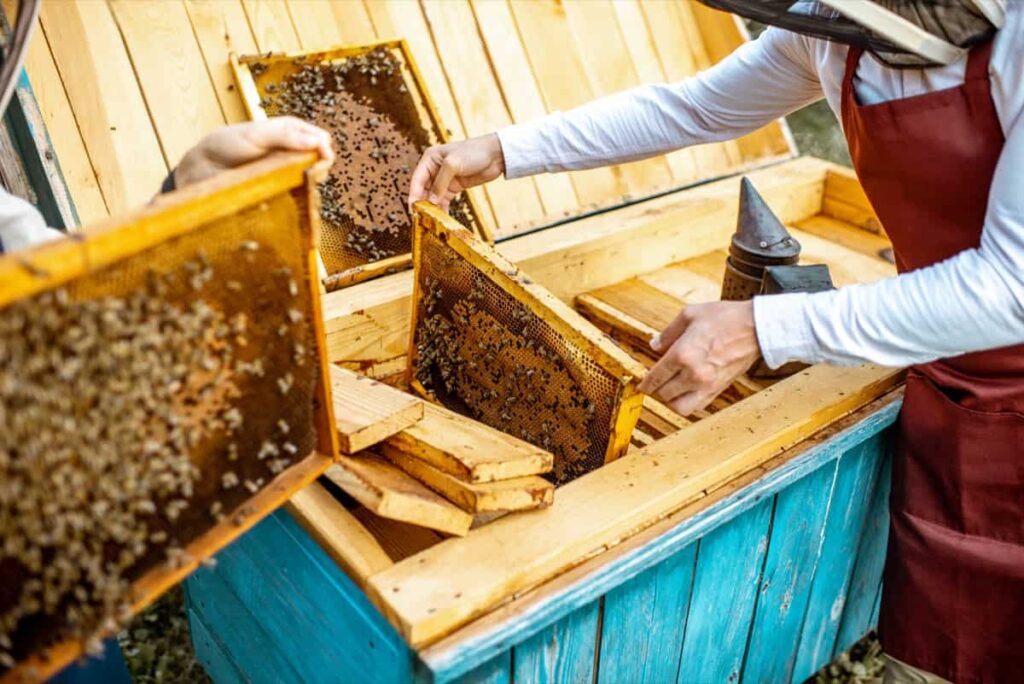
Furthermore, larger operations may require specialized equipment like automated honey extractors ($500 to $2000) and climate-controlled storage spaces, which can cost upwards of $300 depending on the size and specifications. Labor costs are another factor; you may need help with hive maintenance, honey extraction, and other tasks, costing around $10 to $20 per hour. Expanding your beekeeping operation could easily add thousands of dollars to your annual expenses.
Potential Income from Backyard Beekeeping
The profitability of backyard beekeeping varies based on several factors, such as the health of the bee colonies, market prices for honey, and the efficiency of your operation. Typically, one beehive can make about 30 to 50 pounds of honey each year. You can sell it for $5 to $10 per pound, which means you can earn $150 to $500 from each hive every year. Apart from honey, beeswax, propolis, and royal jelly can also provide additional income.
Beeswax can sell for $5 to $10 per pound, and a healthy hive can produce about 1 to 2 pounds of wax annually. Royal jelly and propolis are niche markets but can fetch a high price, often more than $20 for small quantities. If managed efficiently, a small backyard beekeeping operation with around three hives could potentially bring in $450 to $1500 per year, not counting the additional revenue from other bee products.
Tips for Reducing Backyard Beekeeping Costs
Reducing costs can make your backyard beekeeping venture more profitable. One of the most effective ways is to build your hives; DIY hive kits can cost as low as $100 to $200, offering considerable savings. Buying bees and equipment in bulk or as a group can reduce per-item costs. Utilize natural pest control and disease prevention methods to save on chemical treatments.
Harvesting honey manually without an extractor can save money, although this is more labor-intensive. Reusing jars and other packaging materials for your honey can lower your operating expenses. Finally, consider trading your products or services with other local farmers or beekeepers to get reduced or no-cost supplies. Being resourceful and vigilant about your expenditures can significantly reduce beekeeping costs and increase profitability.
Conclusion
Backyard beekeeping can be a rewarding but financially challenging endeavor. The initial setup, ongoing maintenance, legal considerations, and potential for expansion come with varying costs. However, you can profit from selling honey and other bee-related products with diligent management and strategic planning.
In case you missed it: Growing Stages of Onions and Onion Growth Time Lapse
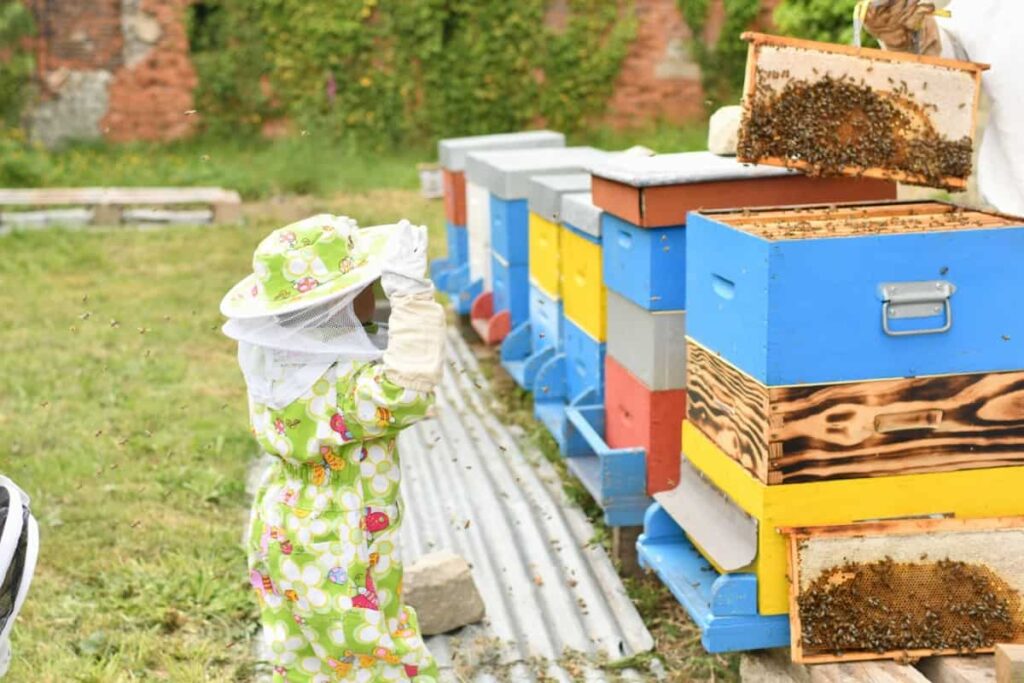
Reducing your operational costs through smart purchasing decisions, DIY projects, and natural alternatives for hive health can further boost your bottom line. While the financial aspects of beekeeping should not be taken lightly, neither should the potential for income and the intrinsic rewards of nurturing these incredible creatures. By understanding the full scope of the costs and potential revenues involved, you can make informed decisions to help you succeed in this fulfilling venture.
- Crops Grown in Summer Season: Best Choices for Summer Gardening
- Organic Pest Control for Tomato Farming
- How to Maximize Sheep Farming Profit
- Broccoli Varieties: Choosing the Right Cultivars for Your Farm
- How to Raise Pigs in Your Own Backyard: A Comprehensive Guide
- Budget Friendly Sheep Shed Ideas: Cheap and Low-Cost Tips
- How Much Do Cattle Farmers Make: Revenue Streams in Cattle Farming
- Management Pests and Diseases in Your Cotton Field
- Sheep Farming Business Plan for Beginners
- Aquaponic Farming at Home: A Step-By-Step Guide
- Profitable Village Farming Business Ideas in 2024
- High-Yield Aquaculture: Fast-Growing Fish for Farming
- Effective Fish Pond Construction Techniques for Beginners
- Irrigation and Water Management in Pineapple Farming
- Blossom to Harvest: Mastering Flowering and Pollination in Papaya Farming
- Pig Fattening Essentials: From Selection to Sale for Beginners
- Raising Wagyu Cattle: A Complete Guide for Premium Beef Production
- Soil Types and Their Water Holding Capacity
- Optimizing Irrigation Schedules for Coconut Groves for Enhanced Yield
- Espresso Your Garden: Coffee Grounds for Healthier Acid-Loving Plants
- The Best Soil Mix for Snake Plants: How to Mix Your Own Snake Plant Soil
- Green Thumb Success: Expert Tips for Cultivating Greenhouse Beans All Year Round
- Bloom All Year Round: The Ultimate Guide to Indoor Hyacinth Care
- Eco-Friendly Gardening: How to Make Liquid Fertilizer from Kitchen Waste
- Ultimate Guide to Grow Anise in Pots: Explore Seed Propagation to Harvesting
- Guide to Raising Chester White Pigs: Discover Breed Facts to Growth Management
- Mastering the Elegance: The Ultimate Guide to Weeping Cherry Tree Care, Planting, and Maintenance
- Ultimate Guide to Planting Garlic in Grow Bags: Growing Strategies for Beginners
- How to Fix Spider Plant Leaf-Related Problems: Natural and Organic Remedies
- 10 Reasons Why Your Tulsi Plant is Shedding Leaves: Home Remedies and Solutions
- Optimizing Growth and Yield: The Advantages of Palm Bunch Ash Fertilizer
- Utilizing Neem Oil Extract as a Natural Pesticide for Hydrangea
- From Soil to Harvest: Various Ways in Which Farmers Can Use AI Tools
- Steps to Encourage and Induce Citrus Flowers: A Comprehensive Guide
- How to Fix Snake Plant Leaf-Related Issues: Natural and Organic Remedies
- Transform Your Garden into a Fragrant Oasis with Raat Ki Rani (Night Blooming Jasmine)
